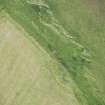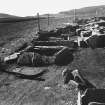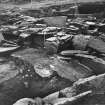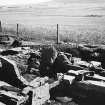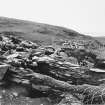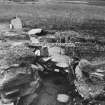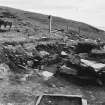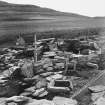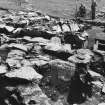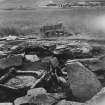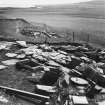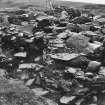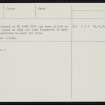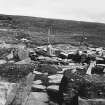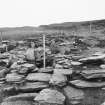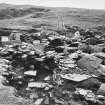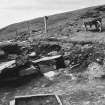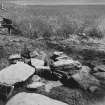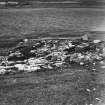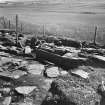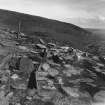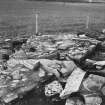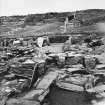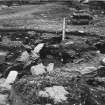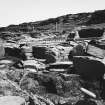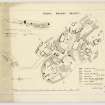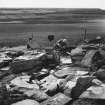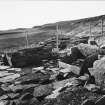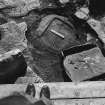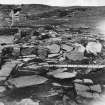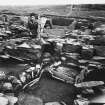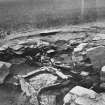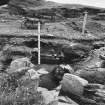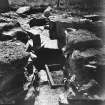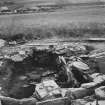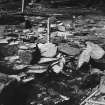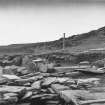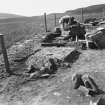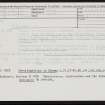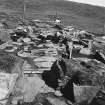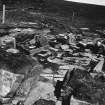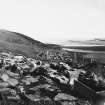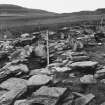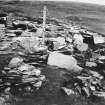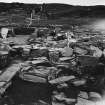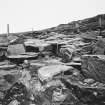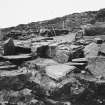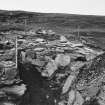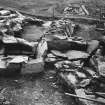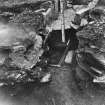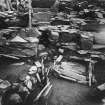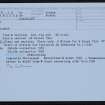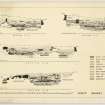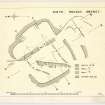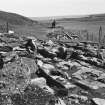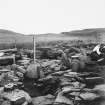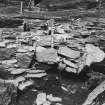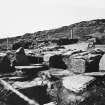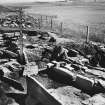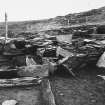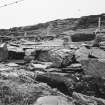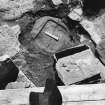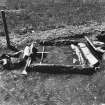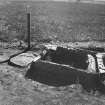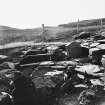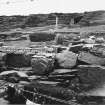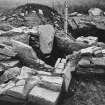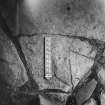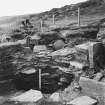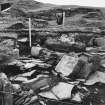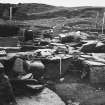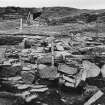Following the launch of trove.scot in February 2025 we are now planning the retiral of some of our webservices. Canmore will be switched off on 24th June 2025. Information about the closure can be found on the HES website: Retiral of HES web services | Historic Environment Scotland
Rousay, Rinyo
Settlement (Neolithic), Beaker (Pottery)(Bronze Age)
Site Name Rousay, Rinyo
Classification Settlement (Neolithic), Beaker (Pottery)(Bronze Age)
Alternative Name(s) Braes Of Rinyo; Bigland Farm
Canmore ID 2717
Site Number HY43SW 20
NGR HY 4398 3224
Datum OSGB36 - NGR
Permalink http://canmore.org.uk/site/2717
- Council Orkney Islands
- Parish Rousay And Egilsay
- Former Region Orkney Islands Area
- Former District Orkney
- Former County Orkney
HY43SW 20 4398 3224
For comparable settlements at Skara Brae (Mainland), Barnhouse (Mainland) and Pool (Sanday), see HY21NW 12.00, HY31SW 61-2 and HY63NW 17 respectively.
(HY 440 321) This Neolithic settlement, type site for the Rinyo-Clacton Culture, was excavated in 1938 and again in 1946 by Professor V G Childe and W G Grant. It was found to be very similar to Skara Brae (HY21NW 12.00), 15 miles away to the SW. The finds consisted of numerous pot-sherds, including some of beaker ware, 250 flint implements including a polished knife; stone axes and balls, an 'ovoid B' stone mace-head, a mortar and potlids, most of which were presented to the National Museum of Antiquities of Scotland (NMAS).
V G Childe 1939; RCAHMS 1946, visited 1936; V G Childe 1949; R W Feachem 1963.
The Beaker sherd held from Rinyo is held in the NMAS under accession number HDA 99. It is assigned to Clarke's N3 ('Late Northern British') group.
[Illustrated: chronological significance discussed].
D L Clarke 1970.
The Rinyo settlement at HY 4398 3224 has been filled in and only a few slabs on edge and some fragments of drystone walling protrude to mark the site.
Surveyed at 1/2500.
Visited by OS (ISS) 18 October 1972.
Excavation (June 1938 - July 1938)
Excavated by Childe and W G Grant in 1938. Further excavations took place in 1946.
V G Childe and W G Grant 1938
Excavation (July 1946 - August 1946)
Excavated by Childe and W G Grant.
V G Childe and W G Grant 1949
Note (1982)
Rinyo HY 4398 3224 HY43SW 20
Situated on a terrace about 200m NE of Bigland, an extensive settlement of neolithic date was revealed by excavations in 1937-8 and 1946. At least seven houses were represented, some superimposed, the best preserved measuring about 5.5m across, with central hearths, 'beds' and floor-boxes. Several of the houses were furnished with drains. The base of a clay oven has been preserved in NMAS along with the pottery, flint and stone objects. The site has now been backfilled and is marked only by a few upright slabs and stretches of drystone walling.
RCAHMS 1982
(Plans in Orkney Archives, copies in NMRS; The Scotsman 30 July 1938; Childe and Grant 1939; Childe and Grant 1947; RCAHMS 1946, ii, p. 227, No. 609 and pp. 362-4, appendix No. 4; Switsur and Harkness in Renfrew 1979, 72 and 206; Ritchie and Ritchie 1981, 42-3; OR 633)
Magnetometry (26 June 2010 - 27 June 2010)
HY 4398 3224 Approximately 1.2ha of gradiometer survey was undertaken on 26–27 June 2010 over the site of the
Neolithic settlement of Rinyo, as part of the second season of the ‘Orkney – Gateway to the Atlantic Project’. The survey
covered the scheduled area and extended across the terrace on which the site is located, in order to determine the nature
and extents of the deposits beyond those excavated in 1937–38 and 1946 (Childe and Grant 1939; 1949).
The survey appears to have defined the extent of the settlement, which covers an area of c2000 sqm, with responses similar to those noted in the gradiometer surveys around Skara Brae (HY21NW 12), suggesting further structural remains as well as increased magnetic responses probably resulting from Neolithic midden enhanced soils. A number of anomalies suggestive of more modern disturbance and drainage were noted at the periphery of the site, and responses consistent with ploughing were visible across much of the rest of the survey area.
Report: Orkney SMR and RCAHMS (intended)
Funder: Orkney College, NABO and University of Bradford
Magnetometry (16 April 2018 - 26 April 2018)
HY 37051 30722 (North Howe), HY 37274 30377 (South Howe), HY 37352 29774 (Knowe of Rowiegar), HY 37531 29661 (Knowe of Swandro), HY 37626 29296 (Westness Viking Houses), HY 4398 3224 (Rinyo) and HY 40065 27452 (Burrian)
The RGK undertook a survey campaign on Rousay, 16 – 26 April 2018, as part of the Boyne to Brodgar Project. It aimed to provide a landscape perspective of two Neolithic core areas on the island – Westside and Rinyo. Moreover, the diachronic development in both areas will be researched, concentrating on the processes of formation and degradation of land use over time.
At Westside the survey area stretched from Westness Farm in the S to the rugged area N of North Howe, where the rocky surface and shrubbery prevented further activity (c56ha). The survey focused on the lower fields close to the coast and to the known Neolithic chambered cairns of Knowe of Swandro, Knowe of Rowiegar and Mid Howe. Some fields had to be omitted because the device could not drive across their steep slopes and rocky ground. Several new anthropogenic anomalies and structures can be observed in the imagery. In the SE field of the surveyed area a possible new mound is most striking. A circular structure, 9.5m in diameter, of high magnetic susceptibility was evident about 250m NW of the mound. In the N further settlement structures surrounding North Howe Broch have been revealed. Track-like linear structures follow downhill from the N towards the SW, and E of these, and NW of North Howe several possible settlement structures are evident. Three circular roundhouse structures are located 20m N of the broch, their diameter is between 8.5 and 11m. Immediately W of North Howe a concentration of stone might result from broch related debris, but could also reveal remains of further building activity in this location. Further investigations will hopefully reveal details about the chronology and function of some of the anomaly clusters.
The Neolithic settlement of Rinyo is positioned in a valley between Faraclet Head and Kierfea Hill in the N of Rousay. During the survey, 50.5ha of gradiometer data were captured from fields surrounding Bigland and Houseby Farms in the S of the valley. The NW area of the survey showed traces of ploughing and some field boundaries. Apart from the interior structuring of Rinyo settlement site several new features have been identified in the adjacent fields to the N and S. A circular to oval structure of 20 – 22m in diameter is positioned about 40m NW of Rinyo’s extent. Inside the settlement, internal details can be identified, and the magnetic susceptibility of the structure is relatively high with values up to 18.0 nT. In the field SE of Rinyo, a cluster of several structures is evident. Several circular and semi-circular features with diameters between 12 – 22m, as well as linear anomalies, signify a focus of settlement activity. About 100m SE of the modern Bigland Farm a further nucleus of settlement or burial activity of uncertain date and type was found. A linear structure in the SW of the surveyed area could result from an igneous dyke. Several anthropogenic anomalies can be found around the dyke.
Two fields were surveyed N of Burrian Broch on the S coast of Rousay. Part of the broch has eroded into the sea and the part facing the coast was not accessible with the 3m rig. The N part of the cavity wall and the possible outer boundary ditch are visible in the magnetometry data. The fields contain dipole anomalies, probably resulting from modern metal waste. Some faint traces of rig and furrow-like features can be detected in the areas close to the coast. Several linear features of higher magnetic susceptibility may also be of modern origin (heavily burnt material was visible on the ground surface).
This report highlights some of the larger structures brought to light with the surveys. Many further features, visible of in the imagery, are still undergoing analysis, and more complementary work is needed to further identify their function and chronology, and their meaning in the composite usage of the land.
Gradiometer survey was predominantly conducted with a GPS-supported 14-sensor fluxgate GM650B gradiometer device mounted on a quad-drawn 3m wide rig. At Westside, the fields close to the sea were not accessible with the large rig. These were surveyed with a 2m rig mounted with five sensors with a similar technical configuration to the larger one.
The works were carried out in collaboration with the University of the Highlands and Islands Archaeology Institute, Orkney College, County Archaeologist Julie Gibson, Orkney Islands Council, the National Museum of Scotland and University College Dublin.
All survey results are reported to Historic Environment Scotland and the Rousay Community
Funder: RGK
Ruth Beusing and Knut Rassmann – Römisch-Germanische Kommission, Frankfurt (RGK) of the German Archaeological Institut (Deutsches Archäologisches Institut)
(Source DES Volume 19)









































































































